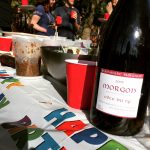Truchot 2005 Morey-St-Denis “Vieilles Vignes” (Burgundy) — Almost carbonic, in the spiky freshness of the wrinkled cherry fruit. A hint of brett. But so, so vibrant and alive. (4/16)
thor iverson
Happy crew
Champalou 2002 Vouvray “La Cuvée des Fondraux” (Vouvray) — Very advanced for a 2002, soft lanolin and lotion and fluff. A pillow of a wine. That Kermit Lynch thinks this is the Vouvray he should import is a bigger story than the wine itself, frankly. (4/16)
Henry
Spreitzer 2007 Winkeler Jesuitengarten Riesling Spätlese 025 08 (Rheingau) — Biting metallic apricot, a spot of cream. Brace, but also weight. Very “Rheingau,” says the friend who brought it. I agree. Age it longer if you crave that sort of thing (and I sometimes do), but the midpoint here is fun. (4/16)
White privilege
Wine is getting whiter. The ascendance of white wine as not only the most logical, but the default accompaniment to dining at any level is all but complete.
Sure, there are always exceptions. Some of them are establishment- or cuisine-specific, some of them are national or regional, and of course there are individual holdouts who find the thought of drinking anything they can see through utterly inconceivable. But in defiance of seasonality, and whether amidst gilded formality or tchotchke-littered casualness, wine consumed in quantity (that is, by the bottle) increasingly tends to be white. The reason: it makes a whole lot more sense as an accompaniment to the food.
Eternal
![[lytton springs]](http://www.thoriverson.com/wp-content/uploads/2016/04/13020316_10207588911375443_1687458016_n-150x150.jpg) Ridge 2013 Lytton Springs (Sonoma County) — Surprisingly accessible for a young Lytton, which is usually heavily structured and/or laden with the coconutty oak that’s the house style. Lytton is almost always one for the long haul…I might, in a feisty mood, argue that it outperforms Geyserville for sheer ageability…but this is already so fruit-forward and delicious, I wonder if it’s not a medium-term wine at most. Still, there’s certainly no rush. (4/16)
Ridge 2013 Lytton Springs (Sonoma County) — Surprisingly accessible for a young Lytton, which is usually heavily structured and/or laden with the coconutty oak that’s the house style. Lytton is almost always one for the long haul…I might, in a feisty mood, argue that it outperforms Geyserville for sheer ageability…but this is already so fruit-forward and delicious, I wonder if it’s not a medium-term wine at most. Still, there’s certainly no rush. (4/16)
Pygmalion
 Jean-Marc Burgaud 2005 Morgon Côte du Py (Beaujolais) — From magnum. The knock against Burgaud is that they start hard and stay hard. (Insert your own joke here.) That’s somewhat true, eleven years down the road, but then a Côte du Py should be structured. Still, it’s only somewhat true; the wine’s aromatically accessible, its darker reds softened to an early autumn sunrise, showing half gamay freshness and half pinot noir sophistication, with aged underbrush imbuing the fruit. Will it age longer? Almost certainly, though note the bottle size. Will it get better? I’d wager on another five years with confidence; after that, it depends on one’s taste. (4/16)
Jean-Marc Burgaud 2005 Morgon Côte du Py (Beaujolais) — From magnum. The knock against Burgaud is that they start hard and stay hard. (Insert your own joke here.) That’s somewhat true, eleven years down the road, but then a Côte du Py should be structured. Still, it’s only somewhat true; the wine’s aromatically accessible, its darker reds softened to an early autumn sunrise, showing half gamay freshness and half pinot noir sophistication, with aged underbrush imbuing the fruit. Will it age longer? Almost certainly, though note the bottle size. Will it get better? I’d wager on another five years with confidence; after that, it depends on one’s taste. (4/16)
Morphic resonance
Sheldrake Point 2013 Dry Riesling (Finger Lakes) — I can’t quite decide if this is flat or blocky. I guess the utterly boring formlessness means it’s flat. Finishes…well, “stale” is the best word for it. I sense the effort towards power, but nothing’s achieved.
![[boulard]](http://www.thoriverson.com/wp-content/uploads/2016/04/13063432_10207627975912032_2782869431833357665_o-150x150.jpg)
![[te awa]](http://www.thoriverson.com/wp-content/uploads/2016/04/13063447_10207621631673430_3781346317639228080_o-150x150.jpg)
![[bedrock]](http://www.thoriverson.com/wp-content/uploads/2016/04/12998183_10207595326615820_6291630473945956894_o-150x150.jpg)
![[white wines]](http://www.thoriverson.com/wp-content/uploads/2016/04/IMG_8743-800x600.jpg)